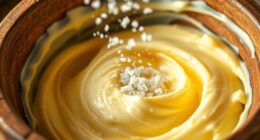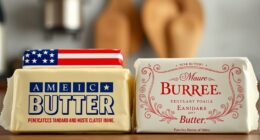Edible butter films offer a sustainable packaging option by using natural, biodegradable ingredients like fats, proteins, and polysaccharides, which help preserve food while reducing environmental impact. These films are made through techniques such as casting and extrusion, providing advantages like being lightweight, edible, and effective moisture barriers. Although challenges remain, ongoing innovations aim to improve their durability and shelf life. Exploring this further reveals how these eco-friendly films could transform food packaging and waste reduction efforts.
Key Takeaways
- Edible butter films are biodegradable, edible, and made from natural materials like fats, proteins, and polysaccharides, supporting sustainability.
- Manufacturing techniques include solution casting and extrusion, with ongoing innovations to improve barrier and mechanical properties.
- They extend food shelf life by providing effective moisture and microbial barriers, reducing packaging waste and environmental impact.
- Challenges involve limited shelf life, moisture sensitivity, and maintaining structural integrity in humid conditions.
- Regulatory compliance and safety testing are essential for market approval, with future developments aiming to enhance durability and cost-effectiveness.
Composition and Material Properties of Edible Butter Films

The composition of edible butter films primarily involves fats, proteins, and polysaccharides, each contributing unique properties to the final product. Fats provide a barrier to moisture, enhancing the film’s protective qualities, while proteins add strength and structure. Polysaccharides, such as cellulose derivatives, improve flexibility and aid in film formation. These components not only influence the physical characteristics but also offer nutritional benefits, making the film edible and nutritious. Additionally, certain ingredients impart antimicrobial properties, helping to extend food shelf life naturally. By carefully balancing these materials, you create a film that’s both functional and beneficial. This combination ensures the edible butter film can effectively protect food and provide health advantages, making it a promising alternative to traditional packaging materials. The process of designing these films also involves understanding sound design principles to optimize their sensory and functional qualities, ensuring they meet consumer expectations.
Manufacturing Techniques for Edible Butter Films

To produce high-quality edible butter films, manufacturers typically start with solution casting or extrusion methods. Film casting involves spreading a prepared solution onto a flat surface, then drying it into a thin film. Microbial fermentation often enhances the biopolymer properties, improving film flexibility and strength. Extrusion pushes the material through a die, creating uniform films efficiently. These techniques guarantee consistency and scalability for sustainable packaging. Additionally, embracing remote hackathons can foster innovation by enabling diverse teams to collaborate on developing advanced biopolymer materials.
Advantages Over Conventional Packaging Materials
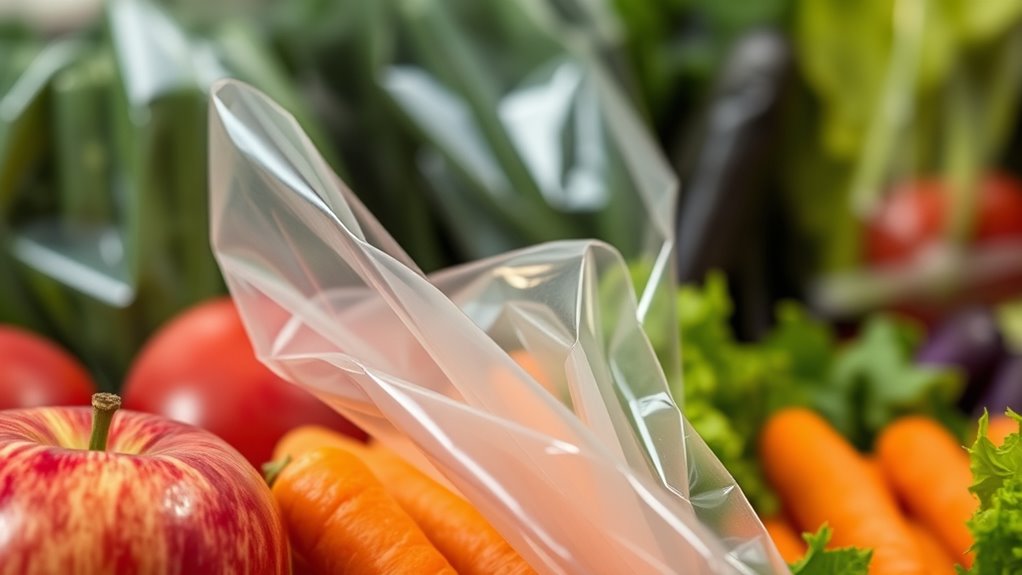
Edible butter films offer several advantages over conventional packaging materials, primarily because they are biodegradable and edible, reducing environmental impact. They can extend shelf life by providing an effective moisture barrier, protecting the product from humidity and spoilage. Unlike plastic wraps, these films dissolve or are consumed along with the food, eliminating waste. Their natural composition allows for a customizable moisture barrier, which helps maintain freshness and quality without additional chemicals. Additionally, edible butter films are lightweight and easy to handle, reducing transportation costs. They also appeal to eco-conscious consumers seeking sustainable options. Incorporating color accuracy considerations into their formulation can further enhance visual appeal and consumer acceptance. Overall, their ability to combine functionality with environmental friendliness makes them a compelling alternative to traditional packaging materials.
Environmental Impact and Biodegradability
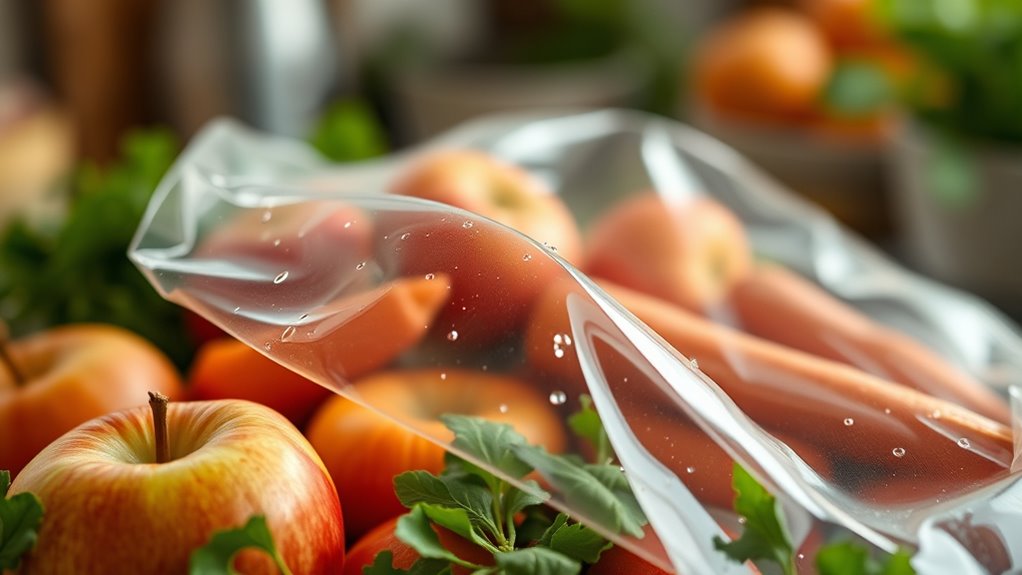
Because they are made from natural, biodegradable materials, edible butter films considerably reduce environmental pollution compared to traditional plastics. Their biodegradability aligns with sustainability metrics that measure ecological impact, making them a greener choice. These films break down naturally without leaving harmful residues, helping to curb plastic waste accumulation. Additionally, they support environmental policies aimed at reducing reliance on non-renewable resources and minimizing landfill burdens. Using edible butter films promotes a circular economy, where materials return to the environment safely. Their eco-friendly nature encourages industries to adopt sustainable practices, fostering long-term environmental health. Implementing vertical storage solutions can further enhance sustainability efforts by optimizing space and reducing waste in manufacturing and packaging processes. Overall, these films provide a responsible alternative that benefits the planet by aligning with global sustainability goals and environmental regulations.
Applications in the Food Industry

Edible butter films offer exciting applications in the food industry by improving preservation and extending shelf life. They can also enhance flavor and texture, making products more appealing. Plus, using these films helps reduce packaging waste, benefiting both consumers and the environment. Incorporating sustainable security measures can further ensure the safety and integrity of these edible packaging solutions.
Edible Coatings Preservation
Have you ever considered how edible coatings can extend the shelf life of food products? These coatings act as a protective layer, reducing moisture loss and preventing microbial growth. Their moisture barrier properties help maintain product freshness longer, reducing spoilage. For example, fruits coated with edible films stay firm and fresh for extended periods. To highlight their benefits, consider this table:
| Benefit | Function | Impact |
|---|---|---|
| Extend shelf life | Limits microbial growth | Less waste, longer storage |
| Moisture barrier | Prevents moisture loss | Keeps product moist |
| Eco-friendly | Made from natural ingredients | Sustainable packaging |
| Cost-effective | Reduces need for preservatives | Saves money |
Using edible coatings in food preservation offers a sustainable way to keep products fresh and reduce waste. Additionally, incorporating innovative materials can further enhance their effectiveness and versatility in the food industry.
Flavor Enhancement Benefits
Did you know that edible coatings can also boost the flavor of food products? By incorporating flavor infusion, these films can enhance taste and aroma, making your food more appealing. The thin layer allows for direct contact with the product, intensifying natural flavors or adding subtle notes. Aroma enhancement is another benefit, as the coatings trap and release fragrant compounds, elevating the sensory experience. This technique is especially useful for baked goods, candies, and snacks, where flavor and aroma are key to consumer satisfaction. Using edible butter films, you can improve flavor delivery without adding artificial ingredients, supporting a cleaner label. Ultimately, these films not only preserve but also amplify the flavor profile, making your products more enticing and memorable. Understanding the importance of food behavior can help optimize flavor delivery and consumer preferences.
Reducing Packaging Waste
By incorporating edible butter films, food producers can substantially reduce traditional packaging waste. These films are biodegradable, accelerating biodegradation processes and minimizing environmental impact. Since they are made from sustainable raw material sourcing, they lessen reliance on petroleum-based plastics. Unlike conventional packaging, edible butter films can be consumed along with the product or safely decompose, reducing landfill accumulation. This approach not only cuts down on waste volume but also promotes eco-friendly practices within the food industry. Additionally, utilizing renewable raw materials ensures a more sustainable lifecycle, decreasing the carbon footprint associated with packaging production. Overall, adopting edible butter films helps streamline waste management efforts and supports environmental conservation goals, making food packaging more sustainable and environmentally responsible.
Challenges and Limitations
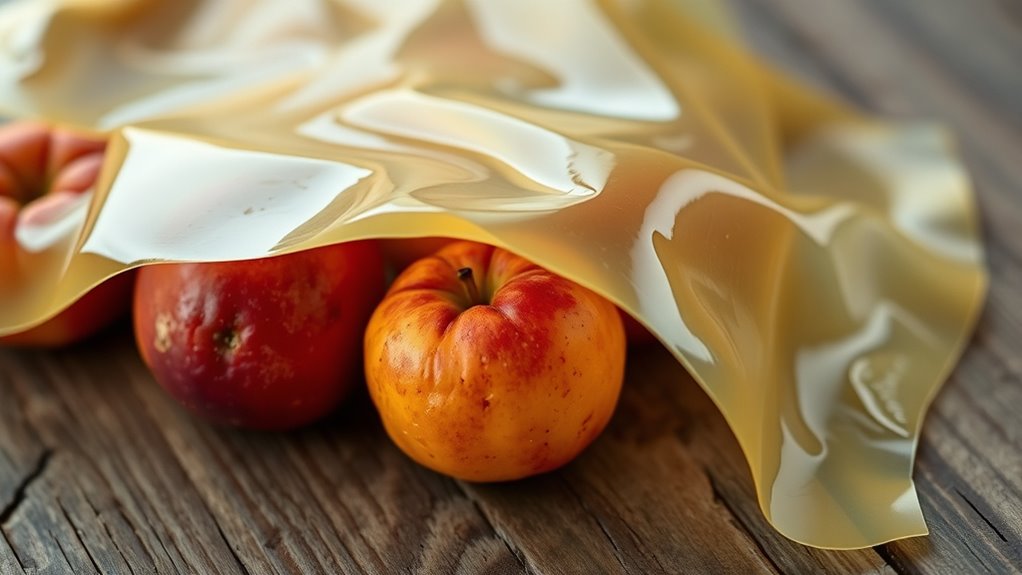
Despite the promising potential of edible butter films, several challenges hinder their widespread adoption. One major issue is their limited shelf life, which can be affected by natural degradation or microbial growth, making them unsuitable for long-term storage. Additionally, their moisture barrier properties often fall short compared to conventional packaging, risking spoilage or quality loss of the food inside. Maintaining the structural integrity of these films in various environments remains difficult, especially in humid conditions. Furthermore, balancing biodegradability with sufficient durability is a complex task. These limitations mean that edible butter films still require further research and development to become viable alternatives for mainstream food packaging. Innovations such as unique and wicked planters can inspire new approaches to sustainable design. Overcoming these hurdles is essential for their successful integration into sustainable packaging solutions.
Consumer Acceptance and Sensory Aspects
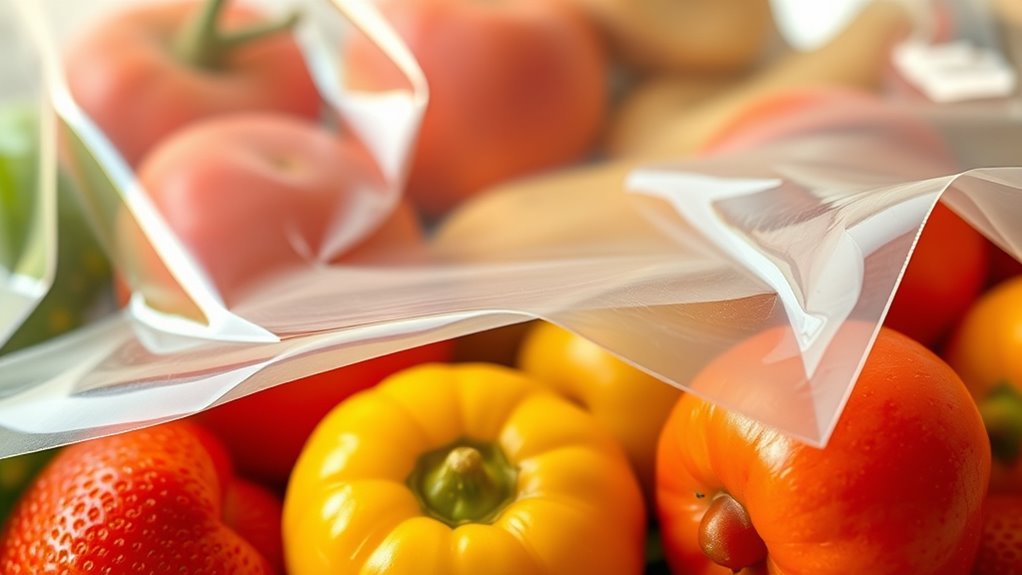
Your acceptance of edible butter films depends heavily on their taste and texture, which need to meet your preferences. Visual appeal and clarity also play a vital role in whether you find these films attractive and appetizing. Understanding what aspects matter most to you can guide improvements that boost overall consumer acceptance.
Taste and Texture Preferences
Taste and texture are essential factors influencing consumer acceptance of edible butter films. You want the flavor to be compatible with the food it coats, ensuring it enhances rather than overpowering the original taste. A pleasant flavor profile encourages repeat use and positive feedback. Texture also plays a vital role; offering a variety of textural options can meet diverse preferences and improve overall satisfaction. Some consumers favor a firm, crisp layer, while others prefer a softer, more pliable film. Achieving the right balance between flavor compatibility and textural variety is key to making edible butter films appealing. Additionally, understanding consumer preferences and sensory aspects can guide the development of products that better meet market demands. When these sensory aspects align with consumer expectations, acceptance increases, paving the way for sustainable, eco-friendly packaging solutions that people genuinely enjoy using.
Visual Appeal and Clarity
The visual appeal and clarity of edible butter films considerably influence consumer acceptance by making the product immediately attractive and reassuring. Bright color vibrancy enhances the film’s aesthetic, signaling freshness and quality, which draws customers’ attention. Meanwhile, high visual transparency allows consumers to see the underlying product, reinforcing confidence in the film’s purity and safety. A clear, visually appealing film also highlights the natural qualities of the butter, emphasizing its freshness and natural ingredients. These visual cues can positively impact perception, encouraging purchase decisions. Ensuring consistent color vibrancy and maintaining transparency are essential for creating an appealing, trustworthy packaging solution. When the visual aspects align with quality expectations, consumer satisfaction increases, fostering acceptance of edible butter films as a sustainable and attractive alternative for food packaging. Incorporating appealing visual elements can further enhance the overall aesthetic and consumer appeal of the product.
Future Perspectives and Innovations

Advancements in material science and food technology are paving the way for innovative applications of edible butter films. You can expect future developments to focus on integrating biodegradable plastics and utilizing renewable resources, making these films even more sustainable. Researchers are exploring new formulations that enhance barrier properties, extend shelf life, and improve mechanical strength without compromising edibility. With ongoing innovations, edible butter films could become a key component in reducing plastic waste and reliance on non-renewable resources. These advancements also aim to lower production costs and increase scalability, making eco-friendly packaging accessible to more producers. Overall, the future of edible butter films looks promising, driven by a commitment to sustainability and technological progress, offering you a practical and environmentally responsible packaging alternative.
Regulatory and Safety Considerations
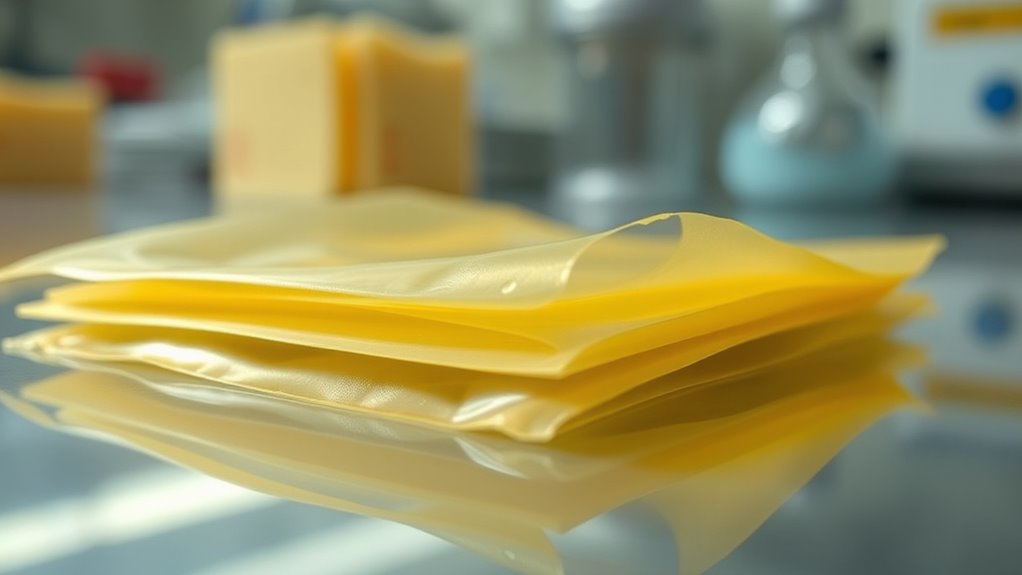
Ensuring the safety and regulatory compliance of edible butter films is essential before they can reach consumers. You must adhere to strict labeling standards and safety regulations to guarantee product integrity. Regulatory agencies require clear ingredient lists, allergen warnings, and usage instructions to protect consumers. Compliance involves demonstrating that the films are safe, non-toxic, and suitable for consumption.
| Aspect | Requirement | Responsible Party |
|---|---|---|
| Labeling Standards | Clear, accurate, allergen info | Manufacturers |
| Safety Testing | Toxicity, biodegradability | Regulatory Bodies |
| Compliance Documentation | Certification, safety reports | Producers, Regulators |
Frequently Asked Questions
How Long Do Edible Butter Films Typically Last Before Degradation?
You might wonder about the shelf life and degradation timeline of edible butter films. Typically, these films last around a few hours to a few days before starting to degrade, depending on storage conditions. Factors like humidity, temperature, and exposure to air influence how long they remain effective. Proper storage can extend their usability, but ultimately, they’re designed to biodegrade quickly once exposed to natural elements.
Are There Any Allergies Associated With Edible Butter Film Ingredients?
Did you know that allergies affect about 15 million Americans? When it comes to edible butter films, allergenic concerns depend on their ingredients. You should check if they contain common allergens like dairy or nuts, as ingredient safety varies. While most ingredients are generally safe, always read labels carefully and consult with a healthcare professional if you have food allergies to avoid any adverse reactions.
Can Edible Butter Films Be Used for Hot or Moist Foods?
You can use edible butter films for hot or moist foods, but their heat resistance and moisture stability are key factors. Typically, these films aren’t designed to withstand high temperatures or prolonged exposure to moisture without breaking down. If you’re planning to use them for hot or moist foods, make certain they have adequate heat resistance and moisture stability so they keep their integrity and effectively protect the food.
How Cost-Effective Are Edible Butter Films Compared to Traditional Packaging?
You might find it interesting that edible butter films could be more cost-effective than traditional packaging. The cost comparison reveals that, thanks to lower production expenses and eco-friendly materials, these films could reduce waste and disposal costs. While initial investments may be higher, their sustainability benefits and potential for local sourcing help balance the scales. Overall, they offer a promising alternative that could save money and support greener practices.
What Are the Storage Requirements for Maintaining Edible Butter Film Quality?
You need to focus on maintaining proper storage conditions to keep edible butter film quality. Shelf stability depends on temperature control; store the films in a cool, dry place away from direct sunlight. Keep the environment consistent, ideally at low temperatures, to prevent spoilage or degradation. Proper packaging and moisture control also help preserve the films, ensuring they remain effective and safe for use in food packaging applications.
Conclusion
While edible butter films promise a sustainable future, their adoption faces challenges just like traditional packaging. You see, despite their eco-friendly nature, issues like shelf life and consumer acceptance linger—reminding us that innovation often walks a fine line between progress and practicality. Embracing these films means balancing environmental benefits with real-world limitations, showing that true sustainability isn’t just about materials, but also about overcoming hurdles to create a greener, more conscious food industry.






